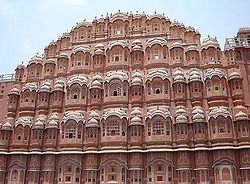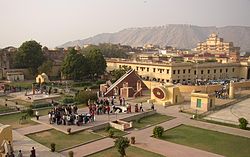- Dhundhar
-
Historical Region of North India
DhundharLocation Rajastan Flag of 19th c. 
State established: 10th c. Language Dhundari Dynasties Chanda(till 10th c.)
Kachwahas (967-1949)Historical capitals Dausa, Amber, Jaipur Separated states Bharatpur, Alwar, Karauli Dhundhar (also Jaipur region, in different times was also known as Kachwaha Kingdom, Amber Kingdom, Jaipur Kingdom) is a historical region of Rajasthan state in western India. It includes the districts of Jaipur, Dausa, Sawai Madhopur, and Tonk and the northern part of Karauli District. The region lies in east-central Rajasthan, and is bounded by the Aravalli Range on the northwest, Ajmer to the west, Mewar region to the southwest, Hadoti region to the south, and Alwar, Bharatpur, and Karauli districts to the east.
Contents
Geography
In 1900, at the times of Jaipur Kingdom, region had a total area of 15,579 square miles (40,349 km²).
The southern and central portions of the region lie in the basin of the Banas River and its tributaries, including the Dhund River, which gives its name to the region. The northern portion of the region is drained by the Ban Ganga River, which originates in Jaipur district and flows east to join the Yamuna in Uttar Pradesh state.
History
The Chanda clan of Meena kings were the chief of different parts of Dhundhar and later on the region was governed by the Kachwaha dynasty of Rajputs. Kachwahas ruled from the 11th century until after India's independence in 1947.
According to Tod the Meena King Raja Ralun Singh also known as Alan Singh Chanda of Khogong kind-heartedly adopted a stranded Rajput mother and her child who sought refuge in his realm. Later, the Meena king sent the child, Dhola Rae, to Delhi to represent the Meena kingdom. The Rajput, in gratitude for these favours, returned with Rajput conspirers and massacred the weaponless Meenas on Diwali while performings rituals i.e. Pitra Trapan, it is customery in the Meenas to be weaponless at the time of PitraTrapan, "filling the reservoirs in which the Meenas bathed with their dead bodies" [Tod.II.281] and thus conquered Khogong.This act of Kachwaha Rajputs was termed as most coward and shameful in history of Rajasthan.
He then subjugated the Sihra Gotra of Meenas at much later on known as Jamwa Ramgarh near Jaipur, and transferred his capital thence. Becoming the son-in-law of the prince of Ajmer, he died when battling 11,000 Meenas,most of whom he slew [Tod.II.282]. His son Maidul Rae "made a conquest of Amber from the Soosawut Meenas" whose King was the head of the Meena confederation. He subdued the Nandla Meenas, annexing the Gatoor-Gatti district [Tod.II.282]. Hoondeo succeeded to the throne and "continued the warfare against the Meenas" [Tod.II.282]. Koontal, his successor, fought the Meenas "in which the Meenas were defeated with great slaughter, which secured his rule throughout Dhundhar" [Tod.II.282]. The Meenas were the original builders of Amber, which town they consecrated to Amba, the Mother Goddess, whom they knew as "Gatta Rani" or "Queen of the Pass" [Tod.II.282]. Amber, India Fort view from Jaigarh
Describing the destruction of the Meena town of Naed, Tod wrote: "When this latter prince (Baharmull Cuchwaha, a contemporary of Babar and Humayun) destroyed the Meena sovereignty of Naend, he levelled its half hundred gates, and erected the town of Lohan (now the residence of a Rajawut chief) on its ruins" [Tod.II.283]. The name of Meena ruler of Naen\Nahn was Rao Bada Meena, he was so rich that his wealth was compared to Akbar's empire in a local saying as "Rao Bada ko Bijano, Akabar Ko Gharbaar" that mean Rao Bada's manual fan was so precious that it was compared with Akbar's palace.
The Kachwaha Rajput ruler Bharmal of Amber always eyed on Nahn and attacked on it several times but could not succeeded against mighty and brave Bada Meena. Akbar had asked Rao Bada to marry his daughter Shashivadini to Akbar. Later on Bharmal married his daughter Jodhabai to Akbar. Then the combined army of Akbar and Bharmal attacked Bada Meena and killed him damaging 52 kots and 56 gates. Bada's treasure was shared between Akbar and Bharmal. Bharmal kept his treasure in Jaigarh fort near Amber.
The hill that Jaigarh was built was called Chil Tila, when it was ruled by Meenas. Later on The state is said to have been founded about eleventh century or 1097 by Dūlaha Rāya, who hailed from Gwalior; he and his Kachwaha kinsmen are said to have absorbed or driven out the local Meenas and Bargujar Rajput chiefs. In which the Meenas were to become a key ally of the Kachwahas. The state is said to have been founded in the eleventh century or 1097 by Dūhaladeva (popularly known by his folk name of Tejkaranj -'the Bridegroom prince'), who hailed from Gwalior; he and his Kachwaha kinsmen are said to have absorbed or driven out the local Meenas and Bargujar Rajput chiefs by deceit and treachery after marriage with daughter of Bargujar King who did not have a son, they later betrayed them as per British Historian Col.James Tod, in his Annals and Antiquities of Rajasthan. The Meenas became a key ally of the Kachwahas. The original capital of Kachwahas in the Dhundhar region was Dausa, then Jamwa Ramgarh, then Amber before the shift to Jaipur.
The ruling dynasty of Jaipur provided the Mughal Empire with some of their most distinguished generals. Among them were Raja Man Singh I, who fought and governed from Kabul to Orissa and Assam; Jai Singh I, commonly known by his imperial title of Mirza Raja, whose name appears in all the wars of Shah Jahan and Aurangzeb; and Jai Singh II, or Sawai Jai Singh, the famous mathematician and astronomer, and the founder of Jaipur city. "Sawai" was a title bestowed upon him by Aurangzeb which meant "one and a quarter times superior to his contemporaries".
Throughout the disintegration of the Mughal Empire, the armies of Jaipur were constantly at war. Towards the end of the 18th century, the Jats of Bharatpur and the chief of Alwar (also a Kachwaha) declared themselves independent from Jaipur and each annexed the eastern portion of Jaipur's territory. This period of Jaipur's history is characterized by internal power-struggles and constant military conflicts with the Marathas, Jats, other Rajput states, as well as the British and the Pindaris (Jaipur's former mercenary allies). Nevertheless, enough wealth remained in Jaipur for the patronage of fine temples/palaces, continuity of its courtly traditions and the well-being of its citizens and merchant communities.
A treaty was initially made by Maharaja Sawai Jagat Singh and the British under Governor General Marquis Wellesley in 1803. However, the treaty was dissolved shortly afterwards by Wellesley's successor, Cornwallis. At this, Jaipur's ambassador to Lord Lake observed that "This was the first time since the English government was established in India that it had been known to make its faith subservient to its convenience". It was later, in 1818, that the Jaipur state entered into subsidiary alliance with the British. In 1835 there was a serious disturbance in the city, after which the British government intervened. The state later became well-governed and prosperous. During the Revolt of 1857 when the British invoked the treaty to request assistance in the suppression of rebellious sepoys, the Maharaja opted to preserve his treaty, and thus sent troops to subdue the uprisings in the area around Gurgaon and the out-skirts of Delhi. The Jaipur forces also secured and kept open the strategic Agra-Ajmer highway. Europeans fleeing from the menace of the mutineers were sheltered in Nahargarh Fort.
Maharaja Sawai Man Singh II (1922–1949) acceded the state of Jaipur to the Government of India in 1948, shortly after India's independence. Jaipur then became the capital of Rajasthan.
The marriage of Jaipur daughter to the Chauhan prince of Devgadh Baria is recorded as one of the most expensive in the world and even Henri Cartier-Bresson the famous photographer has recorded it.
Culture
Generally liberal policies of the rulers permitted Jainism to flourish at Amber and later at Jaipur.
It continues to be one of the most important centers of Jainism in India. It is here where the Bispanthi/Terapanthi divisions among the Jains emerged in 17th century.[1] In 17th century the Chittor seat of the Bhattarakas of Mula Sangh Saraswati gachchha moved from Champawati to Sanganer and then to Amber and finally to Jaipur where the last Bhattarka was present until 1965. The lineage is
- Narendrakirti (Samvat 1691, Sanganer) -
- Surendrakirti (Samvat 1722, Amber) -
- Jagatkirti -
- Devendrakirti -
- Mahendrakirti -
- Kshemendrakirti (Samvat 1815, Jaipur) -
- Surendrakirti -
- Sukhendrakirti -
- Nayankirti -
- Devendrakirti -
- Mahendrakirti - [2]
- Chandrakirti.
Nizamats of Dhundar (Jaipur) State
- Sawai Jaipur
- Daosa
- Gangapur
- Hindaun
- Kot Kasim
- Sawai Madhopur
- Malpura
- Sambhar
- Shekhawati
- Torawati
Thikanas
Tazimi Thikana
Paid upwards of Rs 25000 in state times to the Jaipur state. [3]
- Dhula
- Barwara
- Chomu
- Samode
- Diggi
- Dooni
- Achrol
- Shahpura
- Garh taknet
- Baniyana
- Gudha(chander ji)
- Kalwara (ठिकाना कलवाडा)
- Gijgarh
- Guhala
- Dangarthal
- Marwaa
- Dudu
- Saali
- Saawarda
- Doongri
- Madhogarh
- Mandaa
- Baghera
- Mehndwaas
- khaatu
- Natwaara
- Mundota
- Kaalwaar
- Jobner
- Karansar
- Siras
- Daanta
- saakoon
- Saantha
- Kanota
- Nailaa
- Ajayrajpura
- Kheda
- mahaar
- Sheopur
Khas Chauki
Paid upwards of Rs 10000 in state times to the Jaipur state.[3]
- Bicchao
- Renwal
- Padasoli
- Pachar
- Chitora
- Rausi
- Kailai
- Ramgarh
- Kheri
Mamlaguzar
Special Category, included some of the most prominent families[4] of Jaipur state. Paid nazrana upwards of Rs 30000 in state times to the Jaipur state. Most were closest to the King and his family, others were most prominent and possessed their own army and served directly under Mughals in middle ages.
- Jhalai - A younger branch of Jaipur seat, in case of vacancy, the future king was adopted from Jhalai.
- Isarda - A younger branch of Jhalai seat, in case of vacancy, the future king was adopted from Isarda.
- Baler - A younger branch of Jhalai seat, in case of vacancy, the future king was adopted from Baler.
- Siwar
- Bissau
- Surajgarh
- Dundlodh
- Khetri - Biggest Thikana of Shekhawati confederation.
- Nawalgarh
- Mandawa
- Sikar
- Lawan
- Uniara
- Law
- Nimera
Chakotidar
- Patan - Torawati, a separate state of Tomar Rajputs.[5]
References
- ^ John E. Cort "A Tale of Two Cities: On the Origins of Digambara Sectarianism in North India." L. A. Babb, V. Joshi, and M. W. Meister (eds.), Multiple Histories: Culture and Society in the Study of Rajasthan, 39-83. Jaipur: Rawat, 2002.
- ^ Varni, Jinendra, Jainendra Siddhanta Kosa, in 4 volumes. New Delhi, 1970-1973
- ^ a b Studies In Indian History: Rajasthan Through The Ages,By R.K. Gupta, S.R. Bakshi
- ^ Studies In Indian History: Rajasthan Through The Ages,By R.K. Gupta, S.R. Bakshi, Page 92
- ^ Studies In Indian History: Rajasthan Through The Ages,By R.K. Gupta, S.R. Bakshi, Page 91
Categories:- Indian Princely States
- History of Jaipur
- Regions of Rajasthan
Wikimedia Foundation. 2010.


